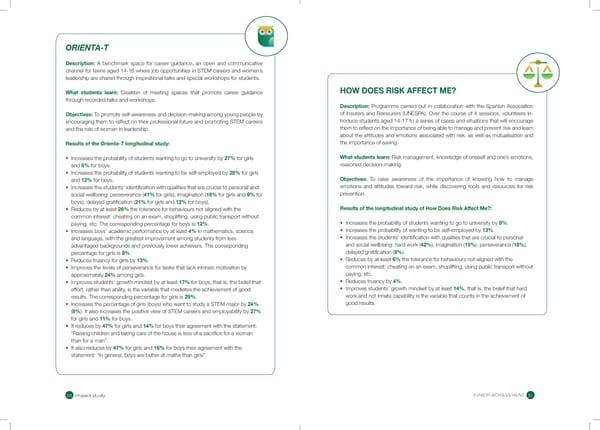ORIENTA-T Description: A benchmark space for career guidance, an open and communicative channel for teens aged 14-16 where job opportunities in STEM careers and women’s leadership are shared through inspirational talks and special workshops for students. What students learn: Creation of meeting spaces that promote career guidance HOW DOES RISK AFFECT ME? through recorded talks and workshops. Description: Programme carried out in collaboration with the Spanish Association Objectives: To promote self-awareness and decision-making among young people by of Insurers and Reinsurers (UNESPA). Over the course of 4 sessions, volunteers in- encouraging them to re ect on their professional future and promoting STEM careers troduce students aged 14-17 to a series of cases and situations that will encourage and the role of women in leadership. them to re ect on the importance of being able to manage and prevent risk and learn about the attitudes and emotions associated with risk, as well as mutualisation and Results of the Orienta-T longitudinal study: the importance of saving. • Increases the probability of students wanting to go to university by 27% for girls What students learn: Risk management, knowledge of oneself and one’s emotions, and 8% for boys. reasoned decision-making. • Increases the probability of students wanting to be self-employed by 28% for girls and 12% for boys. Objectives: To raise awareness of the importance of knowing how to manage • Increases the students’ identi cation with qualities that are crucial to personal and emotions and attitudes toward risk, while discovering tools and resources for risk 41% for girls), imagination (18% for girls and 9% for prevention. social wellbeing: perseverance ( boys), delayed grati cation (21% for girls and 12% for boys). • Reduces by at least 26% the tolerance for behaviours not aligned with the Results of the longitudinal study of How Does Risk Affect Me?: common interest: cheating on an exam, shoplifting, using public transport without 12%. • Increases the probability of students wanting to go to university by 8%. paying, etc. The corresponding percentage for boys is • Increases boys’ academic performance by at least 4% in mathematics, science • Increases the probability of wanting to be self-employed by 13%. and language, with the greatest improvement among students from less • Increases the students’ identi cation with qualities that are crucial to personal 42%), imagination (15%), perseverance (18%), advantaged backgrounds and previously lower achievers. The corresponding and social wellbeing: hard work ( 9%. delayed grati cation (8%). percentage for girls is • Reduces truancy for girls by 13%. • Reduces by at least 6% the tolerance for behaviours not aligned with the • Improves the levels of perseverance for tasks that lack intrinsic motivation by common interest: cheating on an exam, shoplifting, using public transport without 24% among girls. paying, etc. approximately • Improves students’ growth mindset by at least 17% for boys, that is, the belief that • Reduces truancy by 4%. effort, rather than ability, is the variable that mediates the achievement of good • Improves students’ growth mindset by at least 14%, that is, the belief that hard results. The corresponding percentage for girls is 29%. work and not innate capability is the variable that counts in the achievement of • Increases the percentage of girls (boys) who want to study a STEM major by 24% good results. 8%). It also increases the positive view of STEM careers and employability by 27% ( 11% for boys. for girls and • It reduces by 47% for girls and 14% for boys their agreement with the statement: “Raising children and taking care of the house is less of a sacri ce for a woman than for a man”. • It also reduces by 47% for girls and 16% for boys their agreement with the statement: “In general, boys are better at maths than girls”. JUNIOR ACHIEVEMENT ׁ־٪٪UǼȬƇƤɅ٪ȷɅɍƫɬ ֿׁ
 Junior Achievement Foundation Page 15 Page 17
Junior Achievement Foundation Page 15 Page 17